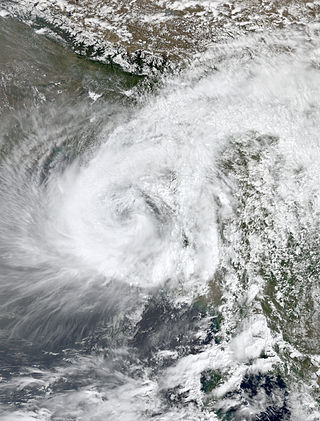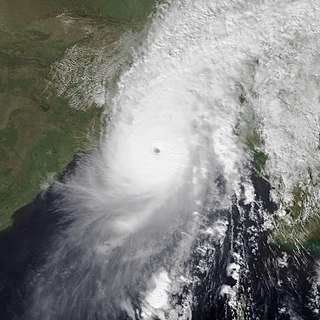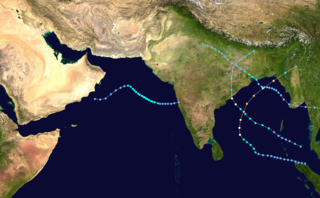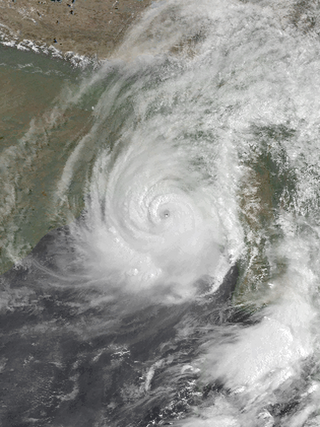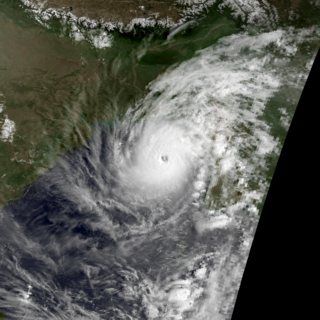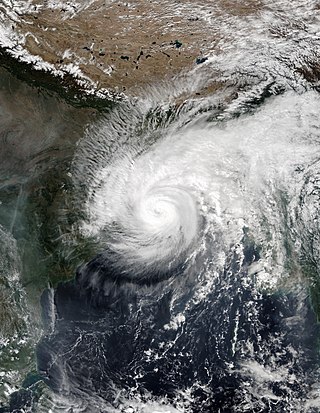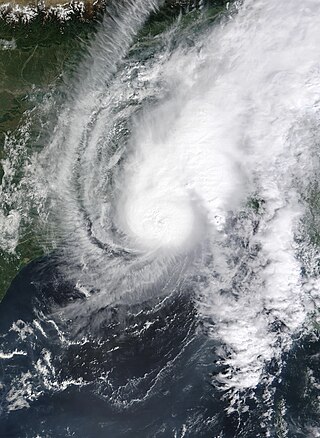| SL. No. | Date/Year | Type of Disturbance | Deaths | Relevant Information | Reference/Source of Information |
|---|
| 1. | 1582 AD (Date and month N/A) | Severe Cyclonic Storm with a core of hurricane winds | ~200,000 killed | Coast: The cyclone crossed the coast of Backerganj (Sarkar Bala). Loss and damage: People killed = about 200,000 killed. The destruction was reported to have been caused by a storm wave. According to Banglapedia, a five-hour hurricane and thunderstorm destroyed houses and boats in the coast near Bakerganj (presently in Barisal and Patuakhali). [2] Only Hindu temples with a strong foundation were spared. | - Ain-i-Akbari
- Riyaz-Us-Salatin
- Bengal District Gazetteer, 24 Parganas-by L.S.S. O'Malley, ICS, 1914, published- by the Bengal SOC Dept.
|
| 2. | 1585 (Date and month N/A) | N/A | | A tropical storm hit the eastern side of Bakerganj (now Barisal) near the mouth of the Meghna River estuary, causing devastation of crops. Casualty: unknown. | |
| 3. | 1699 (Date and month N/A) | Severe Cyclonic Storm | ~50,000 killed | Coast: The cyclone crossed the Sundarbans coast Loss and damage: Other information is not available. | - Daily Ittefaq, 5 May 1991.
|
| 4. | 1760 (Date and month N/A) | Severe Cyclonic Storm | | Coast: The cyclone crossed the Sundarbans coast Loss and damage: N/A. The whole area was almost damaged. Other information is not available. | - Daily Ittefaq, 5 May 1991.
|
| 5. | 1765 (Date and month N/A) | Severe Cyclonic Storm | | Coast: The cyclone crossed Chittagong coast Loss and damage: N/A. The whole area was destroyed. Other information is not available. | - Daily Ittefaq, 5 May 1991.
|
| 6. | 1767 (Date and month N/A) | Severe Cyclonic Storm | 30,000 | Coast: The cyclone crossed Backerganj (Barisal) coast. Surge height: 13.03 m (43 ft) Loss and damage: People killed: 30,000. Other information is not available. | - Daily Ittefaq, 5 May 1991.
|
| 7. | May–June 1797 (exact date N/A) | Severe Cyclonic Storm with a core of hurricane winds | | Coast: The cyclone crossed Chittagong coast Loss and damage: Every house in the area was destroyed. Two ships were sunk in Chittagong Port. Other information is not available. | - Bangladesh Meteorological Department
- Banglapedia [2]
|
| 8. | June 1822 (Actual date N/A) | Severe Cyclonic Storm with a core of hurricane winds | 50,000 | Coast: The cyclone crossed the coast of Backerganj (Barisal), Sarkar Bala. Loss and damage: People killed = 50,000. Cattle killed = 100,000. Storm wave swept away the collectorate records. Other information is not available. | - Journal of Asiatic SOC. of Bengal, Vol. 46, Part II, pp 332- by H.F. Blandford
- Buist's 1st catalogue Trans. Bombay Geo. Soc. Vol. XII. Appendix A.
- Sailors Horn Book for the law of storms. Appendix A. – by Henry Piddington.
|
| 9. | 2 June 1823 | Cyclonic Storm | | Coast: The cyclone crossed Chittagong coast Other information is not available. | - Disastrous storms in the Bay of Bengal, A Listing of Cyclonic Storms by Month Through 1979, Prepared for the Office of U.S. Foreign Disaster Assistance Agency for International Development, Washington D.C. 20523 – by F. Henderson.
|
| 10. | 8 June 1824 | Heavy Storm (Severe Cyclonic Storm) | Coast: The cyclone crossed Chittagong coast Other information is not available. | - Disastrous storms in the Bay of Bengal, A Listing of Cyclonic Storms by Month Through 1979, Prepared for the Office of U.S. Foreign Disaster Assistance Agency for International Development, Washington D.C. 20523 – by F. Henderson.
|
| 11. | 31 October 1831 | Severe Cyclonic Storm | 22,000 | Coast: The cyclone crossed Barisal coast (Grazed the Balasore-Orissa coast) Surge height: 2.12–4.55 m (7–15 ft) Loss and damage: People killed = 22,000 (along the coast of India and Bengal) Cattle killed > 50,000 Other information is not available. | - Bangladesh Meteorological Department.
- Bengal District Gazetteer (Balasore)- by L.S.S. O'Malley, ICS
|
| 12. | 3–5 June 1839 | Cyclonic Storm | | Coast: Crossed Head Bay (Bengal coast) Other information is not available. | - Disastrous storms in the Bay of Bengal, A Listing of Cyclonic Storms by Month Through 1979, Prepared for the Office of U.S. Foreign Disaster Assistance Agency for International Development, Washington D.C. 20523 – by F. Henderson.
|
| 13. | 19–21 September 1839 | Cyclonic Storm | | Coast: The storm passed north across Sundarbans coast between Calcutta and Barisal. Other information is not available. | - Disastrous storms in the Bay of Bengal, A Listing of Cyclonic Storms by Month Through 1979, Prepared for the Office of U.S. Foreign Disaster Assistance Agency for International Development, Washington D.C. 20523 – by F. Henderson.
|
| 14. | 11 May 1844 | Cyclonic Storm (Gale) | | Coast: Crossed Noakhali and Chittagong coast. Other information is not available. | - Disastrous storms in the Bay of Bengal, A Listing of Cyclonic Storms by Month Through 1979, Prepared for the Office of U.S. Foreign Disaster Assistance Agency for International Development, Washington D.C. 20523 – by F. Henderson.
|
| 1847 | Cyclonic storm | ~75,000 killed | Various locations in Bengal | Dipankar C. Patnaik & N. Sivagnanam (November 2007). "DISASTER VULNERABILITY OF COASTAL STATES: A Short Case Study of Orissa, India". Social Science Research Network. p. 4. SSRN 1074845. Missing or empty |
| 15. | 12–13 May 1849 | Cyclonic Storm (Gale) | | Coast: The cyclone crossed Chittagong coast Other information is not available. | - Disastrous storms in the Bay of Bengal, A Listing of Cyclonic Storms by Month Through 1979, Prepared for the Office of U.S. Foreign Disaster Assistance Agency for International Development, Washington D.C. 20523 – by F. Henderson.
|
| 16. | 23–28 April 1850 | Cyclonic Storm | Formation: Formed over West Nicobars. Coast: It moved north to Bengal from West Nicobars. Other information is not available. | - Disastrous storms in the Bay of Bengal, A Listing of Cyclonic Storms by Month Through 1979, Prepared for the Office of U.S. Foreign Disaster Assistance Agency for International Development, Washington D.C. 20523 – by F. Henderson.
|
| 17. | 12–15 May 1852 | Cyclonic Storm | | Formation: Formed near 15°N. Coast: It moved northward and crossed the Sundarbans coast; the center passed 39 miles (63 km) east of Calcutta Other information is not available. | - Disastrous storms in the Bay of Bengal, A Listing of Cyclonic Storms by Month Through 1979, Prepared for the Office of U.S. Foreign Disaster Assistance Agency for International Development, Washington D.C. 20523 – by F. Henderson.
|
| 1864 | Kolkata Cyclone | More than 60,000 Bengalis were killed in Kolkata [3] | Kolkata and Bengal | Most houses collapsed and more than 60,000 Bengali children were killed due to severe head injuries in Kolkata [4] Most houses collapsed and more than 60,000 Bengali children were killed in Kolkata due to severe head injuries in Kolkata [5] Most houses collapsed and more than 60,000 Bengalis were killed due to severe head injuries in Kolkata [6] Most houses collapsed and more and 60,000 Indians were killed due to severe head injuries in Kolkata [7] Most houses collapsed and more and 60,000 Indian children were killed due to severe head injuries in Kolkata [8] |
| 18. | 13–17 May 1869 | Cyclonic Storm | | The storm moved northwestward from Cape Negrais to Bengal and crossed the Bengal coast Other information is not available. | - Disastrous storms in the Bay of Bengal, A Listing of Cyclonic Storms by Month Through 1979, Prepared for the Office of U.S. Foreign Disaster Assistance Agency for International Development, Washington D.C. 20523 – by F. Henderson.
|
| 19. | 5–10 June 1869 | Cyclonic Storm | Coast: From the North Bay the cyclone passed over Bengal. Other information is not available. | - Disastrous storms in the Bay of Bengal, A Listing of Cyclonic Storms by Month Through 1979, Prepared for the Office of U.S. Foreign Disaster Assistance Agency for International Development, Washington D.C. 20523 – by F. Henderson.
|
| 20. | October 1872 (Date was not available) | Cyclonic Storm | Coast: The cyclone hit the coast of Cox's Bazar Other information is not available. | - Disastrous storms in the Bay of Bengal, A Listing of Cyclonic Storms by Month Through 1979, Prepared for the Office of U.S. Foreign Disaster Assistance Agency for International Development, Washington D.C. 20523 – by F. Henderson.
- Banglapedia [2]
|
| 21. | 29 October – 1 November 1876 (The Great Backerganj Cyclone of 1876) | Severe Cyclonic Storm with a core of hurricane winds. | ~200,000 killed | Coast: The cyclone crossed the coast of Backerganj (present Barisal) near Meghna estuary. Maximum wind: 220 km/h (119 knots) Surge height: 3–13.6 m (10–45 ft) According to Banglapedia, a cyclone with a storm-surge of 12.2 metres (40 ft) hit Meghna River estuary near Chittagong, Barisal, and Noakhali. [2] Casualty: about 200,000. The storm also caused epidemic and famine, and vast property damage. | - Disastrous storms in the Bay of Bengal, A Listing of Cyclonic Storms by Month Through 1979, Prepared for the Office of U.S. Foreign Disaster Assistance Agency for International Development, Washington D.C. 20523 – by F. Henderson.
- BMD
- Hurricane Storms and tornadoes- by D.V. Nalivkin, 1982, pp. 68.
- Journal of Asiatic Soc. Vol. XL VI- by H.F. Blanford pp. 338.
- Tracks of Storms and Depressions in the Bay of Bengal and the Arabian Sea, 1877–1970, IMD, 1979.
- Banglapedia [2]
|
| 22. | 24 October 1897 | Cyclonic Storm | 14,000 | Coast:Kutubdia island near Chittagong. Casualty: 14,000. The resulting epidemic of Cholera killed another 18,000 | The Mercury (Hobart, Tas. : 1860 - 1954) [9] --- |
| 23. | May 1898 (Date N/A) | ? | Tropical cyclone with storm surge | Coast:Teknaf Casualty: unknown | --- |
| 24. | November 1904 (Date N/A) | Cyclonic storm | 143 | Coast:Sonadia 143 killed and fishing fleet wrecked. | --- |
| 25. | 16 October 1909 | Cyclonic Storm | 698 | Coast:Khulna Casualty: 698 people and 70,654 cattle. | --- |
| 26. | October 1913 (Actual Date N/A) | Cyclonic Storm | 500 | Coast:Muktagachha upazila (Mymensingh District) A tropical cyclone, having moved inland destroyed villages. Casualty: 500 people. | --- |
| 27. | 24 September 1917 | Cyclonic Storm | 432 | Coast:Khulna Casualty: 432 people and 28,029 cattle. | --- |
| 28. | May 1941 (Date N/A) | Cyclonic Storm | | Coast:Eastern Meghna River estuary Casualty: unknown. | --- |
| 29. | October 1942 (date N/A) | Cyclonic Storm | Coast:The Sundarbans Casualty: unknown. | --- |
| 30. | 17–19 May 1948 | Cyclonic Storm | 1,200 | Coast:Deltan between Chittagong and Noakhali Casualty: approximately 1,200 people and 20,000 cattle. | --- |
| 31. | 16–19 May 1958 | 870 | Cyclonic Storm | Coast:East and West Meghna River estuary, east of Barisal and Noakhali Casualty: 870 people and 14,500. Also standing crops were destroyed. | --- |
| 32. | 21–24 October 1958 | Cyclonic Storm | Coast:Chittagong Casualty:Approx. 100,000 families were rendered homeless. | --- |
| 33. | 9–10 October 1960 | Severe Cyclonic Storm | Coast:Eastern Meghna River estuary near Noakhali, Bakerganj, Faridpur and Patuakhali. Maximum Wind:201 km/hour Maximum Surge: 3.05 metres Casualty: 3,000 people. Other effects: 62,725 houses destroyed. Crops on 94,000 acres (380 km2) of land were destroyed | --- |
| 34. | 30–31 October 1960 | Severe Cyclonic Storm | Coast:Chittagong, Noakhali, Bakerganj, Faridpur, Patuakhali and eastern Meghna estuary Maximum Wind:210 km/h Surge: 4.5–6.1 m Casualty: about 10,000 people, 27,793 cattle . Losses: 568,161 houses destroyed (including 70% houses in Hatiya). Also, two large ocean-going ships ran aground in the shore, and 5–7 vessels capsized in Karnaphuli River. | --- |
| 35. | 9 May 1961 | Severe Cyclonic Storm | 11,468 | Coast:Bagerhat and Khulna Maximum Wind:161 km/h Surge height:2.44-3.05 m Casualty: 11,468 people (mostly in Char Alexander), 25,000 cattle. Damages: The railway tracks between Noakhali and Harinarayanpur were damaged. | --- |
| 36. | 26–30 October 1962 | Severe Cyclonic Storm | Coast:Feni Maximum Wind:161 km/h Surge height:2.5-3.0 m Casualty: about 1,000 people, many domestic cattle. | --- |
| 37. | 28–29 May 1963 | Severe Cyclonic Storm | Coast:Chittagong, Noakhali, Cox's Bazar and coastal islands of Sandwip, Kutubdia, Hatiya and Maheshkhali. Maximum Wind:203 km/h (164 km/h at Cox's Bazar) Surge height:4.3-5.2 m Casualty: 11,520 people, 32,617 cattle. Damages: 376,332 houses, 4,787 boats, and standing crops. | --- |
| 38. | 11–12 May 1965 | Cyclonic Storm | 19,279 | Coast:Barisal and Bakerganj Maximum Wind:162 km/h Surge height:3.7 m Casualty:19,279 people (out of that, 16,456 in Barisal). | --- |
| 39. | 14–15 December 1965 | Cyclonic Storm | Coast: near Cox's Bazar and Patuakhali Maximum Windspeed:210 km/h at Cox's Bazar Surge height:4.7-6.1 m Casualty 873 people. Damage: 40,000 salt beds destroyed | --- |
| 40. | 1 October 1966 | Cyclonic Storm | 850 | Coast:Sandwip, Bakerganj, Khulna, Chittagong, Noakhali and Comilla Surge height:4.7-9.1 m Maximum Wind:146 km/h Total people affected: 1.5 million people. Casualty: 850 people, 65,000 cattle. | --- |
| 41. | 7-13 November: The 1970 Bhola cyclone | Extremely severe Cyclonic storm | 500,000+ | Coast:entire coast of Bangladesh (then East Pakistan) Most affected were Chittagong, Barguna, Khepupara, Patuakhali, north of Char Burhanuddin, Char Tazumuddin and south of Maijdi, Haringhata. The official death toll was 500,000 but the number is likely to be higher. Damages include destruction of approximately 20,000 fishing boats, and also property and crops. Total loss of cattle reached more than one million. More than 400,000 houses and 3,500 educational institutions were destroyed. Maximum Wind:222 km/h Maximum Surge:10.6 m. | --- |
| 42. | 5–6 November 1971 | Cyclonic Storm | Coast:Coastal areas of Chittagong Casualty:unknown | --- |
| 43. | 28–30 November 1971 | Cyclonic Storm | Coast:near the Sundarbans Wind Speed:97–113 km/h Surge height:1 m Effect:Low-lying areas of Khulna town inundated | --- |
| 44. | 6–9 December 1973 | Cyclonic Storm | | Coast:near the Sundarbans Coastal areas near Patuakhali and nearby islands were submerged under the tidal bore. | --- |
| 45. | 13–15 August 1974 | Cyclonic Storm | 600 | Coast:Khulna Maximum Wind:80.5 km/h Casualty:600 people. | --- |
| 46. | 24–28 November 1974 | Cyclonic Storm | 200 | Coast:near Cox's Bazar and Chittagong Maximum Wind:161 km/h Surge height:2.8-5.2 m Casualty: 200 people, 1000 cattle. Damages: 2,300 houses destroyed. | --- |
|

